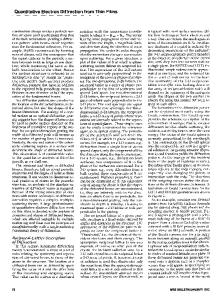Quantitative Electron Diffraction for Crystal Structure Determination
- PDF / 613,345 Bytes
- 7 Pages / 612 x 792 pts (letter) Page_size
- 81 Downloads / 341 Views
1184-GG01-04
Quantitative Electron Diffraction for Crystal Structure Determination Peter Oleynikov1, Daniel Grüner2,3, Daliang Zhang1,2, Junliang Sun1,2, Xiaodong Zou1,2 and Sven Hovmöller1 1 Structural Chemistry, Stockholm University, SE-106 91 Stockholm, Sweden 2 Berzelii Centre EXSELENT on Porous Materials, Stockholm University, SE-106 91 Stockholm, Sweden 3 Inorganic Chemistry, Stockholm University, SE-106 91 Stockholm, Sweden ABSTRACT We present a quantitative investigation of data quality using electron precession, compared to standard selected-area electron diffraction (SAED). Data can be collected on a CCD camera and automatically extracted by computer. The critical question of data quality is addressed – can electron diffraction data compete with X-ray diffraction data in terms of resolution, completeness and quality of intensities? INTRODUCTION X-ray crystallography has been an unprecedented method for determining atomic structures of inorganic crystals, organic molecules and proteins. If crystals of about 0.01 to 1 mm in all three directions can be obtained, then the structure can nearly always be solved to high accuracy, with atomic co-ordinates accurate to within about 0.1 Å for proteins, 0.01 Å for organic molecules and 0.002 Å for inorganic compounds. The main limitation of X-ray diffraction is to obtain sufficiently large single crystals. With the modern trend of nanotechnology, it is becoming increasingly interesting to be able to solve smaller and smaller crystals. Heavy developments are presently ongoing on synchrotrons, with the aim of making intense X-ray beams down to 1 µm in diameter. An alternative to single crystal X-ray diffraction is powder X-ray diffraction. In powder diffraction, the 3D pattern of diffraction spots is projected onto a 1D spectrum, creating big problems of overlapping diffraction peaks. This makes it very hard to solve complicated crystal structures by powder diffraction. Electron diffraction can be obtained from crystals a million times smaller than the smallest that are feasible for X-ray diffraction, i.e. down to sizes of about 10x10x10 nm3. Unfortunately, there are other problems with electron diffraction that has limited the usefulness of electron crystallography. Until now, it has been very difficult to collect complete and highquality diffraction data by electron diffraction. The traditional method to collect electron diffraction data is selected-area electron diffraction, SAED. Because of the very short wavelength of electrons, 0.02-0.03 Å, compared to 0.5-2 Å for X-rays, the reflections that are simultaneously in diffracting condition lie almost on a flat plane. This makes it possible to record a geometrically undistorted diffraction pattern up to 1 Å resolution or higher in a single exposure in the electron microscope. The drawback of the very strong interaction of electrons with matter (about a million times stronger than X-rays) is multiple scattering. Unless the sample is extremely thin ( 10 Å, it becomes necessary to have data also from several projections
Data Loading...











